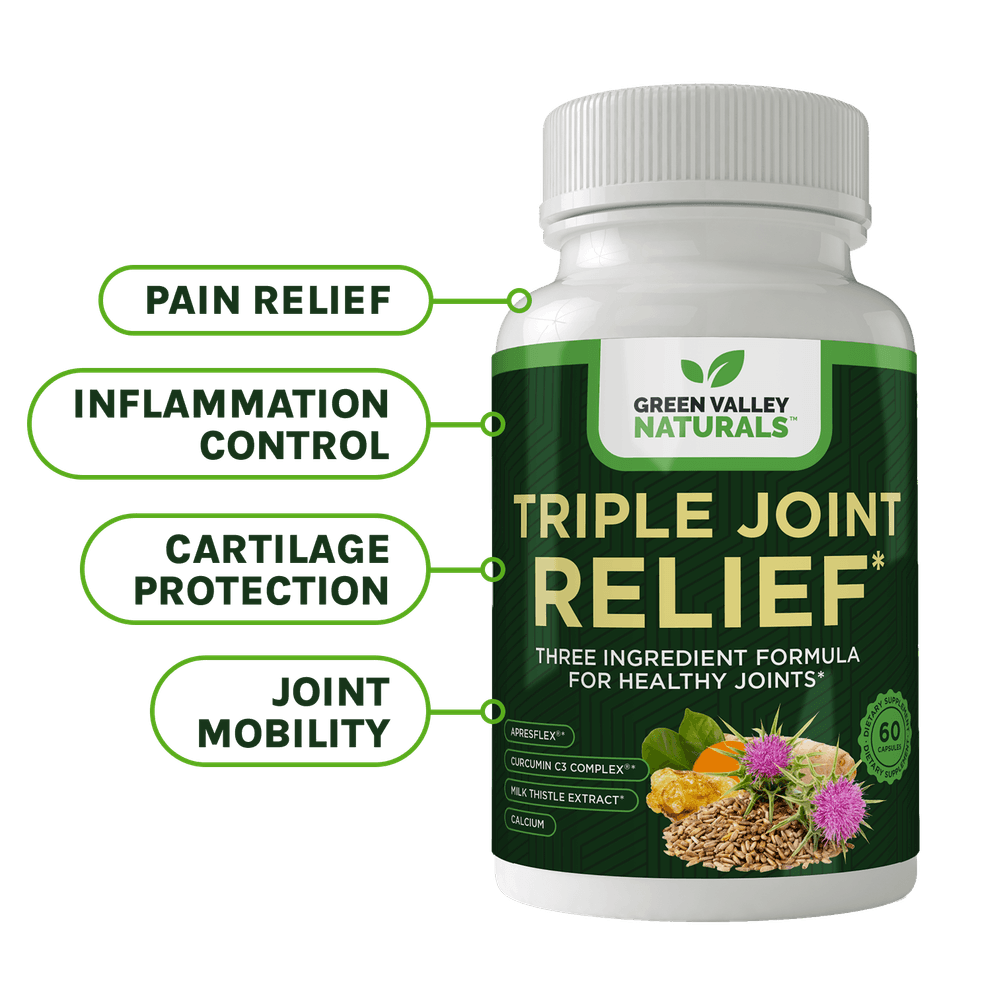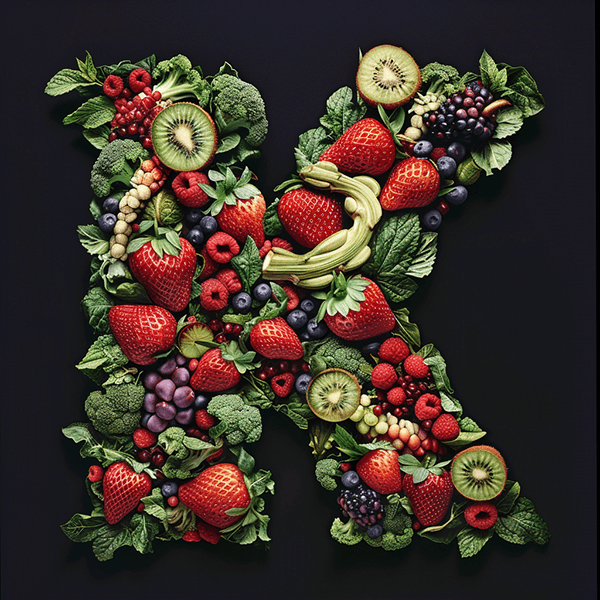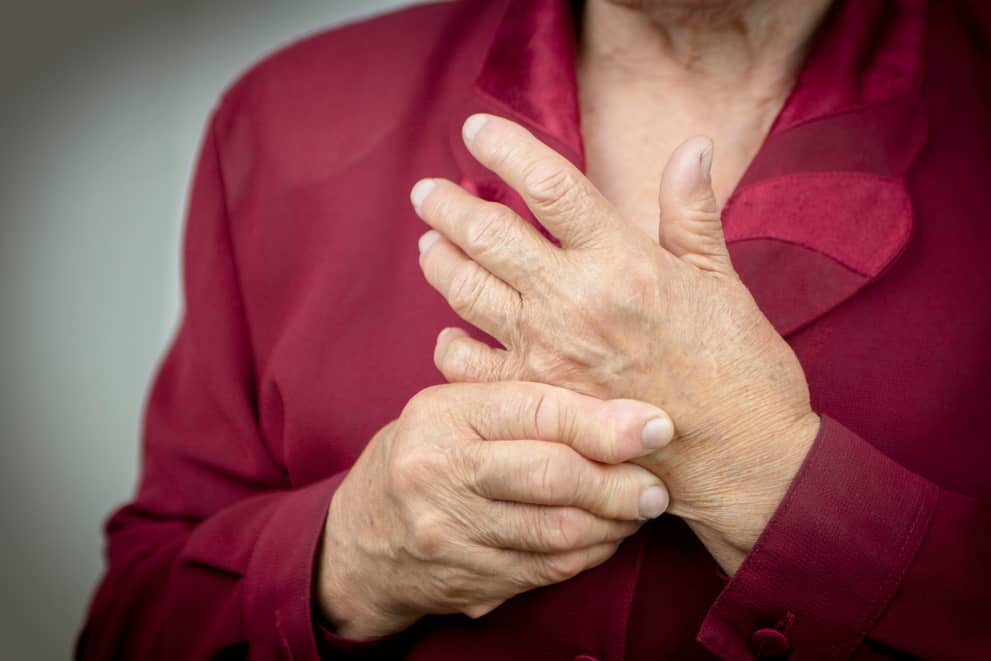
Picture this: You wake up on a crisp morning, ready to take your usual walk around the neighborhood. But as you swing your legs out of bed, a familiar ache shoots through your knees. The stairs that once seemed effortless now require careful planning. Simple tasks like getting up from your favorite chair have become small victories rather than automatic movements.
If this scenario sounds familiar, you're not alone. You're part of a growing community of more than 30 million Americans living with joint pain. Pain that doesn't just affect your joints, but transforms how you move through the world every single day.
For decades, the medical advice for joint pain has remained frustratingly limited: maintain a healthy weight, stay active, and manage your discomfort with pills as best you can. But what if there was something more? What if a nutrient hiding in your salad bowl could hold the key to slowing down this joint-destroying wear and tear?
Key Takeaways
Vitamin K Helps Prevent Joint Calcification: It works with vitamin D to activate proteins that keep calcium from damaging joint cartilage.
Low Vitamin K = Higher Joint Risk: Deficiency doesn’t directly cause joint and bone pain, but it can worsen inflammation and calcium buildup in damaged joints.
Simple Diet Changes Can Help: Foods like spinach, kale, parsley, broccoli, and even prunes are rich in vitamin K and easy to incorporate daily. Vitamin K supplementation is also important.
The Vitamin K Revolution: More Than Just Blood Health
You may have learned about vitamin K in high school biology as "that vitamin that helps your blood clot." And while that's absolutely true—vitamin K prevents us from bleeding excessively when we get a cut—scientists at Tufts University's Human Nutrition Research Center on Aging are uncovering a much more complex story.
Dr. Sarah Booth, who directs the Vitamin K Laboratory at Tufts, has spent over a decade investigating something remarkable: vitamin K's potential role in keeping our joint cartilage (also known as articular cartilage) healthy and functional. Her work, along with colleague Dr. Kyla Shea, represents some of the most promising research in joint health and pain prevention we've seen in years.
"What's really compelling about the osteoarthritis story is that there is no medical treatment for it, even though osteoarthritis is the most common disabling disease in the lower extremities in older adults," Dr. Booth explains. "People are looking for dietary interventions, and vitamin K has promise."
Think about that for a moment. Despite affecting millions of Americans and being the leading cause of disability in older adults, we still don't have effective treatments for many cases of chronic joint pain beyond symptom management.
Understanding Your Enemy: What Really Happens in Joint Pain
Before we dive into vitamin K's protective powers, let's understand what we're fighting against. Joint pain isn't just "wear and tear" on your joints—it can come from a complex degeneration that affects the entire joint structure.
Imagine your joints as sophisticated shock absorbers. At the ends of your bones, you have smooth, slippery cartilage that allows bones to glide past each other effortlessly. In healthy joints, this cartilage is constantly maintaining and repairing itself, like a well-oiled machine.
But sometimes, this delicate balance breaks down. The articular cartilage begins to deteriorate, becoming rough and worn. As it wears away, bones begin to rub directly against each other, causing pain, swelling, and stiffness. Over time, the joint may change shape entirely, with bone spurs forming around the edges and small pieces of bone or cartilage breaking off to float painfully within the joint space.
These structural changes can trigger the release of pro inflammatory cytokines that result in chronic inflammation and chronic pain.
The Calcium Connection: When Good Minerals Go Bad
Here's where the vitamin K story gets fascinating. Dr. Booth and Dr. Shea have focused their research on a process called calcification—essentially, the harmful buildup of calcium in joint cartilage where it doesn't belong.
Now, calcium is absolutely essential for our health, particularly for strong bones and teeth. But like many good things, calcium becomes problematic when it ends up in the wrong places. When calcium deposits form in joint cartilage, they contribute to stiffness, pain, and further joint damage.
This is where vitamin K steps in as a molecular guardian. Research suggests that vitamin K works alongside vitamin D to prevent this harmful calcification process. It's like having a sophisticated security system that ensures calcium goes where it's needed (your bones) and stays away from where it can cause trouble (your joint cartilage).
The Dynamic Duo: How Vitamins K and D Protect Your Joints
The relationship between vitamins K and D is like a perfectly choreographed dance. Each vitamin has a specific role, but they work together to protect your joints in ways that neither could accomplish alone.
Here's how the process works: Your joint tissues need vitamin D to manufacture a protein called matrix-Gla protein, or MGP. Think of MGP as a molecular bouncer whose job is to prevent calcium from setting up shop in your cartilage. But here's the catch—MGP can't do its job properly without vitamin K.
Vitamin K triggers a crucial biochemical change that makes MGP fully functional. Without adequate vitamin K, it's like having a security guard who's present but can't actually stop troublemakers from entering. The calcium deposits form anyway, contributing to joint damage and pain.
This discovery suggests that maintaining adequate levels of both vitamins K and D might help preserve joint function and relieve joint pain.
The Research That's Changing Everything
Dr. Shea's groundbreaking study on the association between vitamin K and joint pain, published in the journal Arthritis Care & Research and funded by the National Institutes of Health, followed two groups of older adults (average age 60–75) for four to five years.1
In the first part of the study, researchers evaluated participants' daily intake of vitamins K and D through detailed food questionnaires. Every year for four years, they tested participants' walking speed and ability to perform chair stands—a crucial test of leg function that many people with joint pain struggle with. In its most basic form, a chair stand involves sitting in a standard chair (usually without arms), crossing your arms over your chest or keeping them at your sides, standing up fully and sitting back down without using your hands.
The second part of the study took a different approach, measuring actual blood levels of vitamins K and D and tracking lower-extremity function over time.
The results from both studies painted a consistent picture: patients who had adequate levels of both vitamin K and D could walk their usual distances faster and had an easier time rising from chairs and sitting back down. These might seem like small improvements, but for someone living with joint pain, the ability to get up from a chair without knee pain or to walk without slowing down can mean the difference between independence and disability.
Further studies and clinical trials examining vitamin K are needed, but the reality is that most people need to consider increasing their intake regardless of their joint health, knee structure or overall joint comfort level.
The Alarming Vitamin K Deficiency Crisis
Here's something that might surprise you: many Americans aren't getting enough vitamin K. Recent research by graduate students in Dr. Booth's lab revealed some concerning trends about vitamin K intake in the United States.2
Their analysis of data from the National Health and Nutrition Examination Survey showed that vitamin K deficiency is more common than many people realize. While older women now generally meet the adequate intake recommendations, an estimated 65% of older men fall short of the recommended daily amounts.
The recommended adequate daily intake of vitamin K is 120 micrograms for men aged 19 and older, and 90 micrograms for women in the same age group. To put this in perspective, one cup of raw spinach contains about 145 micrograms of vitamin K—more than a full day's requirement. Yet many people consistently fall short of these targets or their bodies aren't absorbing enough vitamin K.
"In the late 1990s, older men and women were consuming below the adequate intake of vitamin K," Dr. Booth notes. "Older women now meet the adequate intake, but we estimate about 65 percent of men are not meeting the current adequate intake."
This deficiency becomes particularly concerning when we consider Dr. Booth's theory about how vitamin K deficiency contributes to joint problems: "We believe that vitamin deficiency isn't what causes the start of calcification. Something else will start the process, such as injury or inflammation. Then, if there's not enough vitamin K, MGP doesn't function, and it can't stop the calcification from spreading."
In other words, vitamin K deficiency might not cause joint pain, but it could make existing joint problems worse by allowing harmful calcium deposits (cartilage calcification) to spread unchecked.
Your Complete Guide to Vitamin K-Rich Foods
Leafy Green Pain-Relieving Powerhouses
Green leafy vegetables are the undisputed champions of vitamin K content. These vegetables contain phylloquinone, the main form of vitamin K found in plant foods.
Kale: One cup of raw kale provides an impressive 113 micrograms of vitamin K—nearly a full day's worth for women
Spinach: Fresh spinach delivers about 145 micrograms per cup raw, or 889 micrograms when cooked
Swiss chard: One cup of raw Swiss chard contains approximately 299 micrograms
Collard greens: A cup of raw collard greens provides about 184 micrograms
Arugula: This peppery green offers around 22 micrograms per cup
Romaine lettuce: Even iceberg's more nutritious cousin provides about 57 micrograms per cup
Cruciferous Vegetables For Better Feeling Joints
These vegetables are not only rich in vitamin K but also provide numerous other health benefits.
Broccoli: One cup of raw broccoli contains about 93 micrograms of vitamin K
Brussels sprouts: These mini-cabbages pack approximately 156 micrograms per cup when raw
Cabbage: Green cabbage provides about 67 micrograms per cup
Cauliflower: While lower than its green cousins, cauliflower still offers about 16 micrograms per cup
Overlooked Herbs and Seasonings Rich in Vitamin K
Don't overlook these flavor enhancers—they're surprisingly rich in vitamin K.
Parsley: Just one tablespoon of fresh parsley provides about 62 micrograms
Cilantro: Fresh cilantro offers approximately 25 micrograms per quarter cup
Basil: Fresh basil leaves contain about 22 micrograms per two tablespoons
Oregano: Dried oregano provides roughly 24 micrograms per tablespoon
Other Excellent Sources of Vitamin K
Asparagus: One cup provides about 91 micrograms
Green beans: A cup of raw green beans contains approximately 43 micrograms
Prunes: These dried plums offer about 65 micrograms per cup
Kiwi fruit: One medium kiwi provides roughly 31 micrograms
Avocado: Half an avocado contains about 10 micrograms
Choosing Vitamin K Supplementation
Supplements can also help. Vitamin K comes in three forms: Vitamin K1 (phylloquinone), Vitamin K2 (menaquinone), and Vitamin K3, the synthetic form of vitamin K.
Vitamin K2, and specifically menaquinone-7 (MK-7), is uniquely synthesized by bacteria and is more bioavailable to your body due to long-chain menaquinones. They contain something called isoprene units according to the numeral following the MK. In other words, MK-7 has seven isoprene units. Study suggests it's the most bioavailable form of vitamin K.
Studies suggest that supplementing with at least 50 mcg of MK-7 a day will help ensure you enjoy the vitamin's health benefits shown in the latest science. But, as we said earlier, not all forms of vitamin K2 and even MK-7 are the same.
Choose Only One-Of-A-Kind Patented K2VITAL® DELTA Vitamin K2
Green Valley Naturals uses the most absorbable form of MK-7, the patented K2VITAL® DELTA Vitamin K2 (as all-trans Menoquinone-7), in all of our supplements. In fact, we have two targeted supplement formulas, a bone health supplement called Bone & Muscle Defense and an inflammation-fighting, joint recovery supplement called Total Joint Relief.
What makes K2VITAL® DELTA so special?
It’s a patented 99.75% all-trans K2 MK-7 – identical to the K2 molecule found in food. K2VITAL® DELTA is fully bioactive. It’s also the first double-encapsulated MK-7, ensuring that even when combined with minerals, MK-7 reaches your bloodstream, where it can flood your body’s cells, joint tissues, and bones.
Recognizing Vitamin K Deficiency: Signs Your Body Needs More Vitamin K
Unlike some vitamin deficiencies that cause dramatic symptoms, vitamin K deficiency can be subtle and develop gradually. However, several signs might indicate you're not getting enough of this crucial nutrient, putting you at risk of chronic diseases.
Easy Bruising and Bleeding
Since vitamin K is essential for blood clotting, deficiency often shows up as increased bleeding and bruising. You might notice:
Bruises appearing more easily than usual
Bruises that are larger or more colorful than expected
Cuts that bleed longer than normal
Nosebleeds that occur more frequently
Heavy menstrual periods (in women)
Bone and Joint Trouble
Given vitamin K’s role in bone metabolism and joint health, deficiency might contribute to:
Increased joint stiffness, particularly in the morning
More frequent joint pain or knee symptoms
Slower recovery from minor joint injuries
Increased susceptibility to fractures
Digestive and Metabolic Problems
Certain conditions can interfere with vitamin K absorption:
Chronic diarrhea or digestive disorders
Liver disease
Cystic fibrosis
Celiac disease or other conditions affecting fat absorption
Medication Interactions
Some medication use can interfere with vitamin K metabolism:
Long-term antibiotic use (which can disrupt gut bacteria that produce vitamin K)
Blood thinners like warfarin (Coumadin)—more on that in a minute
Certain cholesterol-lowering medications
Some seizure medications
Getting Tested: How to Check Your Vitamin K Status
If you're concerned about your vitamin K levels, several tests can help assess your nutritional status. While these tests aren't routinely ordered at your doctor's office, they can be valuable if you have risk factors for deficiency or symptoms that suggest inadequate vitamin K.
Prothrombin Time (PT/INR): This is the most common test related to vitamin K function. It measures how long it takes your blood to clot. While primarily used to monitor blood thinner therapy, an abnormally prolonged PT can indicate vitamin K deficiency.
Plasma Phylloquinone Level: This test directly measures the level of vitamin K1 (phylloquinone) in your blood. It's considered the most accurate way to assess vitamin K status, though it's not widely available and is primarily used in research settings.
Undercarboxylated Osteocalcin: This test measures a protein that depends on vitamin K for proper function. Higher levels of undercarboxylated osteocalcin can indicate functional vitamin K deficiency, even when blood levels appear normal.
PIVKA-II (Protein Induced by Vitamin K Absence): This test measures proteins that are produced when vitamin K is insufficient. Elevated PIVKA-II levels suggest inadequate vitamin K status.
If you're interested in testing your vitamin K status, discuss these options with your healthcare provider. They can help determine which tests are most appropriate for your situation and interpret the results in the context of your overall health.
Important Considerations and Precautions
While the research on vitamin K and joint health is promising, it's important to approach supplementation thoughtfully, especially if you have certain health conditions or take specific medications.
If you take warfarin (Coumadin) or other vitamin K-antagonist blood thinners, maintaining consistent vitamin K intake is crucial. Sudden increases or decreases in vitamin K can affect how well your medication works. This doesn't mean you should avoid vitamin K—quite the opposite. You should aim for consistent daily intake while working with your healthcare provider to monitor your medication dosing.
Beyond Vitamin K: A Comprehensive Approach to Joint Health
While vitamin K research offers new hope for joint pain relief, it's most effective as part of a comprehensive approach to joint health. Here are evidence-based strategies that work alongside adequate vitamin K intake:
Physical Therapy and Exercise: A qualified physical therapist can develop a personalized stretching and strengthening routine that relieves symptoms while keeping you active. Regular exercise is one of the most powerful tools for relieving joint pain.
Weight Management: If you're carrying extra weight, even modest weight loss can significantly reduce pressure on your knee joints and slow disease progression.
Walking and Low-Impact Activities: For people with less joint pain, regular brisk walking or light jogging has been shown in some studies to slow wear and tear on joints rather than accelerate it.
Alternative Therapies: While research is mixed, some people find relief through acupuncture, massage therapy, or other complementary approaches.
Supplement Considerations: Research on glucosamine, chondroitin sulfate, and other "joint support" supplements is mixed, with most studies showing little to no benefit. However, some individuals report improvements. Always discuss supplements with your healthcare provider.
| Action | How To |
|---|---|
| Start Your Day Green | Add spinach or kale to your morning smoothie, or try a green juice with leafy veggies. |
| Think Beyond Salads | Sauté Swiss chard with garlic, add arugula to sandwiches, or blend fresh herbs into sauces. |
| Embrace Cruciferous Veggies | Roast Brussels sprouts with olive oil & balsamic, steam broccoli, or use cauliflower rice as a substitute. |
| Snack Smart | Keep dried fruit like prunes on hand, or enjoy fresh kiwi as a vitamin K–rich snack. |
| Cook with Herbs | Use fresh parsley, basil, and cilantro to boost flavor and vitamin K content. |
Summary
New research reveals that vitamin K, long known for its role in blood clotting, may be a powerful yet underappreciated ally in the fight against joint pain. Scientists at Tufts University found that vitamin K, particularly when paired with vitamin D, helps prevent harmful calcium buildup in joints—a key contributor to cartilage breakdown, joint pain and stiffness. With most Americans falling short on their daily intake, especially older men, increasing vitamin K through food and vitamin K supplementation could be a simple, natural step to support long-term joint health and mobility.
Frequently Asked Questions
How does vitamin K benefit joint health?
Vitamin K activates proteins that prevent calcium from accumulating in joints, protecting cartilage and reducing pain and stiffness.
Can vitamin K reverse osteoarthritis?
No, but it may slow the progression and support better joint function, especially when paired with vitamin D.
What foods are highest in vitamin K?
Leafy greens (like spinach and kale), cruciferous vegetables (like broccoli), and herbs (like parsley and basil) are all rich in vitamin K.
How much vitamin K do I need daily?
Men need about 120 mcg/day; women need 90 mcg/day. One cup of cooked spinach offers over 800 mcg!




